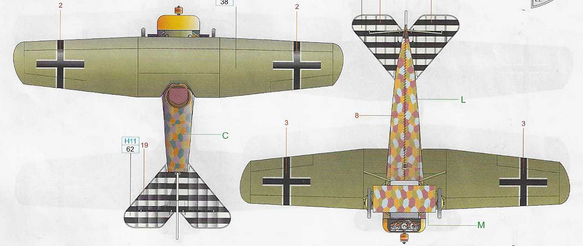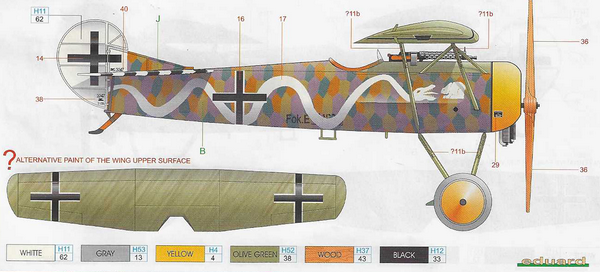|
|
HISTORICAL MINIATURES BY GEORGE GRASSE |
|
|
|
HISTORICAL MINIATURES BY GEORGE GRASSE |
|
WORLD WAR 1 AVIATION SUPPLEMENT
FOKKER E.V/D.VIII WING CAMOUFLAGE MYSTERY
by George Grasse
INDEX
Introduction
Method A - Solid Color
Method B - Streaking with Two Colors
Method C - Streaking in Color Segments
Method D - Streaking with Blended Colors
Method E - Streaking in Two Applications
Method F - Streaking with Blended Colors
Method G - Tainting the Varnish then Apply Streaking
Method H - Streaking with a Mix of Colors
INTRODUCTION
A modeler confronted with building and painting a Fokker E.V/D.VIII (in any scale) has to choose between several public and well-supported theories as to the color(s) and method of wing camouflage application. In the following discussion, I will present differenct techniques that I have encountered.
The Fokker E.V was a unique departure from the design and construction methods of Fokker. Up until the E.V (and it's re-vamped and re-named D.VIII), Fokker wings were wood, wire, and linen covered. The linen was camouflaged with paint either sprayed or brushed or was covered in pre-printed multi-colored lozenge linen then in wide-stread use. The Fokker E.V/D.VIII parasol fighter had wood covered wings so how were they to be camouflaged? There are few photographs of the hundreds available that show a clearly defined camouflage pattern on the upper or undersides of the wing. Most of us would agree that it appears that the camouflage was streaked at an angle but no definitive pattern emerges except in controversy.
The controversy has its roots in the findings of Peter M. Grosz who discovered on a Fokker factory document reference to four colors but without details of how they were to be used on the Fokker E.V. These colors are mocha brown, new true green, azure blue, and azin violet, each one presented in equal portions. Further, there is no way of knowing their exact shades. Many interested modelers have speculated their use given the available photographic evidence. As a result, several versions have emerged. Here are the techniques ascribed in the current body of modeling literature as of 2025. I have arbitrarily assigned letters to each method.
SOLID COLOR: For the upper surface an olive green shade in a number of coats for complete coverage but probably two at the most. For the under surface, pale blue was applied the fuselage, landing gear 'wing', wing, and struts. If the mysterious four colors are taken into account, mocha brown, true green, and azin violet would combine to create the olive green. Two problems result from using these three colors. First, exactly what shade are these colors. Second, what is the ratio of one to the others, if any. The azure blue would be applied to the under surfaces as is but exactly what shade is it? Overall, these would appaear to be the least expensive application method.
In my experiments with the three colors I used Vallejo acrylic paints from theVallejo Model Color range: 959 Purple, 968 Green, and 984 Brown. My only interest was to get a greenish-brown or perhaps an olive shade by adding more or less of one color or another to an approximate start of equal proportions. It didn't take long to achieve the olive green shown in Exhibit A. By adding more of the other colors, the mix stayed in the green-brown range. This result proved to me that a suitable drab paint could be made with these three colors.
 |
| EXHIBIT A: This extract from the kit instruction manual for Eduard's 1:48 scale Fokker E.V (Kit # 8069) shows Method A - Solid Color in the top left corner of the upper surface of the wing, presumably approximating the combination of mocha brown, true green, a azin violet referencing Aqueous color number 52 or Mr. Color number 38, Olive Drab. |
METHOD B - STREAKING WITH ONE COLOR
STREAKING WITH ONE COLOR: With the olive green-brown mixture
or its equivalent (namely mocha brown, true green, and azin violet as listed on
the extant Fokker drawing), this method exactly duplicates the style of finish seen on
other Fokker aircraft of the late 1917 and 1918 periods, namely the Fokker Dr.I
triplance and the Fokker D.VII, among others. The effect of this method is
familiar to all of us and is shown as Exhibit B, again referencing the Eduard
instruction manual. This method introduces a more complex
camouflage paint applicatiion. The technique used to create the streaking
pattern is derived from the decorative paint technique called 'strie painting'
itself from the French word styre' meaning streak in which brush strokes are
made using thinned paint.
 |
| EXHIBIT B: This extract from the kit instruction manual for Eduard's 1:48 scale Fokker E.V (Kit # 8069) shows Method B - Steaking with One Color in the bottom left corner, presumably approximating the combination of mocha brown, true green, a azin violet referencing Aqueous color number 52 or Mr. Color number 38, Olive Drab. The streaking is from the leading edge to the trailing edge at some defined angle, say 45 degrees. The actual method as seen in period photographs is much more hectic with noticeable changes in application. |
METHOD C - STREAKING in COLOR SEGMENTS
Color segments are defined as alternating swaths of two or more colors as seen in German two and three-color schemes in 1916 and 1917. Then, colors used were solid dark green, red brown, and mauve, for example. This method of streaking uses the same mix of the four Fokker E.V colors of mocha brown and true green for the upper surface and azure blue and azin violet for the undersurface. This method is best illustrated by Ronnie Bar's color profiles that appear in his book, German Fighters of the Great War, Volume 2, pages 264-265 as reproduced below.
%20x600.png) %20x600.png) |
| EXHIBIT C: This extract from Ronnie Bar's book German Fighters of the Great War Volume 2, pages 264-265, Morton Books. In both cases the pattern is somewhat less than 45 degrees from the leading edge applied by brush in a downward upper-left to lower-right manner. In a few extant photos, although it is possible to see the angular application, it is not so clear to see segmented patches. |
METHOD D - SOLID APPLICATION IN MIXED COLORS
In this method, all four Fokker drawing colors of mocha brown, true green, azure blue, and azin violet are mixed together and applied to the upper and undersurface. I have one example from Das Propellerblatt, Nummer E4, 2009, inside back cover (page E.123), a three-view color profile by Walter Werner that postulates that all four colors were mixed and applied to both surfaces.
%20x600.jpg) |
| EXHIBIT D: This extract is from Das Propellerblatt, Nummer E4, 2009, inside back cover (page E.123), by Walter Werner. Both surfaces are painted a solid color consisting presumable of a mix of mix all four Fokker colors. Note that there is no streaking. This is a good representation of the Fokker E.V/D/VIII wing dilemma. |
METHOD E - STREAKING IN TWO APPLICATIONS
In this method, all four Fokker drawing colors of mocha brown, true green, azure blue, and azin violet are presumably used. However, as in Method E, mocah brown and true green are used on the upper surface while azure blue and axin violet are used on the undersurface. At this point, the painting procedure differs. For the upper surface (using mocha brown and true green), one of the colors is streaked. When dry, the second color is streaked over the first. The procedure just described is used for the undersurface (using azure blue and azin violet). Which color is first streaked and which color is streaked over it is not defined. The overall effect is shown in Exhibit E below.
.jpg) |
| EXHIBIT E: This extract is from Fokker Aircraft of WW1, Volume 5, 1918 Designs, page 202, by Jack Herris and Jorn Leckscheid, Aeronaut Books, 2023. This is a compelling proposition that includes streaking, segmented sections, and divides the color pallet in two as shown in the lower left corner. This is a good representation of the Fokker E.V/D/VIII wing dilemma. |
METHOD F - PRE-STAINING FOLLOWED BY STREAKING
This method I introduces a different process. What if the unfinished plywood wing covering had its varnish coat mixed with one of the colors from the four-color pallet? To illustrate, let's assume that for the upper surface, brown was introduced to the varnish and applied as such. Over this base color, true green was then streaked. Also, for the under surface, lets assume that azin violet is mixed with varnish and applied to the under surface of the plywood covered wing. When dry, the remaining color, azure blue is applied by streaking. There are variations of course, namely which color is mixed into the varnish first. I don't have an exhibit for this method.
METHOD G - FOKKER D.VII STREAKING
This last method reminds us of the fuselage streaking on early Fokker-built D.VII aircraft. In its simplest terms, the Fokker people being cost-conscious simply applied their well-known streaking procedure to the upper surface of the D.VIII wing. The under surface, as with the earlier Fokker Dr.I, was painted in sky (azure) blue overall. I believe that, azure blue aside, the remaining colors of mocha brown, true green, and azin violet were the colors used to create "Fokker olive green".
GO TO?